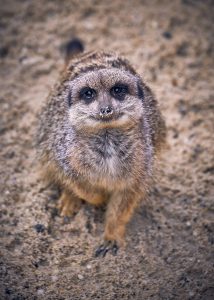To discover about the species of the meerkat, we have to take a trip deep into the sub-Saharan temperatures of the Kalahari Desert in Southern Africa. Amongst the hot desert sands, we can find groups (or mobs) of Meerkats who can live in large groups of up to forty members. A Meerkats skeletal structure has been noted to closely resemble some of the earliest carnivores that roamed the planet and as a member of the mongoose family, they are a very clever and inquisitive species in the animal world. Meerkats can live up to between six to eight years in the wild and have even been known to have a life span of up to fourteen years in captivity. The most commonly known stance of a Meerkat is that of their sentry position, through this position they can stand up to heights of 29cm. Meerkats have a wide array and variation in their diet and are classed as omnivores, they have been known to even challenge prey considerably larger and more dangerous than themselves.

Meerkats are a native species to South Africa, Southern Botswana, Namibia and Angola. As diurnal animals (animals that are awake in the daytime) they emerge from their burrows at sunrise to enjoy the day’s heat. Even though Meerkats themselves are excellent diggers, the burrows they live in will often be preowned by another burrowing animal; a common favourite is those of the African ground squirrel. The burrows will have a vast number of entrances and exits in order to allow quick retreat from predators or assist other members of the mob when they have raised the alarm of a predator whilst on sentry duty. Within the burrows there are tunnels and chambers at varying levels, these can vary in depth and width, depending on sleeping arrangements and toilet facilities. The Meerkats will often dig tunnels as deep as two metres, this allows for the temperature to stay regulated, remaining at a comfortable heat regardless of the vast temperature changes outside the burrows. As, within the desert, temperatures can reach up to a height of 46°C but has the ability to drop down to as low as -12°C in the winter nights. This can pose a threat in both extremes; Meerkats utilise their burrows as a protection from these contrasting temperatures. As diurnal creatures, they take time throughout the day to sunbathe in order to retain heat for the colder nights. The black tip on the end of their tails acts as a sun protectant whilst foraging for food and outside in the heat of the day. The tail is a vital instrument, used to propel themselves when scurrying across the desert from either protection from predators or to aid in attacking their prey. Their darkened skin on their underbelly also protects them from overheating when soaking up the midday sunrays.
Meerkats are highly social animals; they live in large mobs not only for protection but also for company. A matriarchal system is present within mobs, though the dominant female will have several litters not all offspring of the mob will be from her. Unlike other species other members within the mobs are allowed to breed and are bought up by the gang in a team effort; rather than individually. Meerkats exhibit a wide variation in social behaviours within their tight knit communities, the duties of hunting, sentry duty and babysitting are taken in turns and carried out as a team. Often time is taken out in the day to groom each other as well. Whilst on sentry duty, Meerkats will guard their territory by standing on rocks that are at the highest points in their territory. By standing in their upright sentry positions the meerkats are provided with the best outlook of surrounding areas, ensuring the best chance of the mobs’ survival from predators. Meerkats being very intuitive individuals will use different calls such as barks or whistles to alert the group whether a predator is coming from the sky or land. Meerkats have scent pouches located underneath their tails and use these to mark out their territory. This is achieved through rubbing on surrounding rocks and plants to provide a warning to other Meerkats. Meerkat territories can sometimes overlap which can cause fights that can go to death. These scent patches therefore deter these events from happening.
Meerkats spend the majority of their day when not on duty, foraging for food. Meerkats are classed as omnivores due to the nature of their diet. As food can occasionally be difficult to find in the desert, Meerkats have adapted to eating plants as well as other animals. Bugs are a particular favourite of the Meerkats; even dangerous Scorpions are classed as a delicacy. Meerkats will bite the sting off of the Scorpions tail before they tuck into their meal to ensure safety. Older Meerkats will show and teach younger members of the gang how to do this; another way in which the mob works together as one team. For other bugs that may excrete poison, they will roll them along the ground until all the poison is released. Meerkats are immune to venom and have been known as a gang to take on and kill a venomous snake that encroaches into their territory. Water is also a hard commodity to source in the desert, Meerkats will utilise gaining moisture from roots and tubers. Meerkats weigh around 730g and will maintain their weight through continuous hunting each day.
Here at Paradise Wildlife Park, we have four gangs of Meerkats, our gangs are very mischievous and extremely charismatic. Our Meerkats love nothing more than an opportunity to explore and will take any chance to try out different enrichment activities provided by our dedicated small mammal keepers.
Meerkats are currently not listed on the endangered list in the wild, however, they still play a vital role in the natural order and food chain. With consistent portrayal in the media as soft and friendly, the illegal pet trade has seen an increasing demand in the want for Meerkats. This is an unrealistic representation and is a problematic issue for the species. Meerkats are complex and social individuals who require more than can be provided as someone’s pet. Here at Paradise Wildlife Park, we do not support any portrayal of Meerkats as pets, it is important for us all to understand Meerkats play an important role within the natural world and we need to be aware of their continued survival. Here at Paradise, you can adopt one of our mischievous meerkats or you can even come and Meet the Meerkats is an experience where you will gain a great insight into the species whilst being up close and personal.





